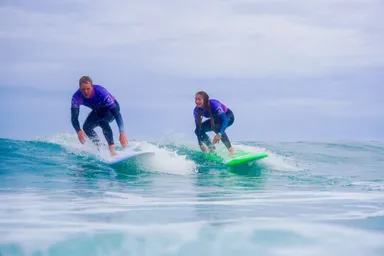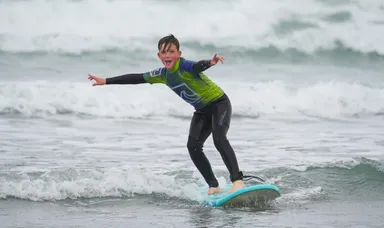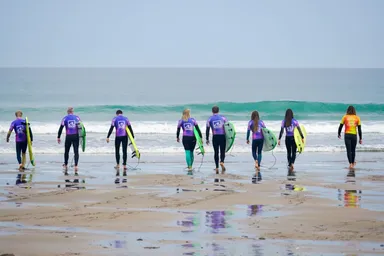How To Paddle Out Back For Beginners

It’s important as a surfer to always stay safe in the line up for both yourself, and your fellow surfers.
Obviously, you should never be paddling out into waves beyond your ability level. But, there does come a time in everyone’s surf journey where they must make the paddle out back in challenging conditions.
This should occur well before you’ve sized down your surfboard, or even moved from foamie to fibreglass.
However, getting a big board out through breaking waves is no small feat. Approaching oncoming waves can be daunting, and often leads to beginner surfers making unsafe decisions in the water.
Safety First
One of the most dangerous things encountered in the line up is the act of ‘ditching’ a surfboard. This is where surfers see a big wave breaking in front of them and jump off their board to submerge. This leaves the surfboard floating out behind them while they duck under the wave.

This is a huge issue in the line up as:
1. Your board will likely hit someone behind you who is also paddling out. You may even possibly hit the surfer riding the wave that just broke over you.
2. Your leash could snap due to the force of the breaking wave. This will leave you in deep trouble and other surfer’s/ lifeguards having to rescue you.
So, what’s a beginner surfer to do in this situation?
There’s a few tried and true methods to getting out into the line up, regardless of your surf craft. Two in particular work extremely well for foam boards and longboards alike, that we’re going to explain to you now.
Once you have an idea of the technique: practice, practice and more practice!
TOP TIP: Try these techniques in smaller, more manageable surf to help you get comfortable performing them. That way, when it comes time to paddle out in punchier, bigger waves, you can be confident that you’re doing your best to stay safe in the surf.
Getting Started

First, you’re going to want to spend five to ten minutes watching the surf. Use this time to analyse what sets are coming through, how many waves per set and roughly how long the lull between sets seems to be. You can combine this with your warm up so that you’re ready to paddle in immediately.
The reason we analyse the surf before entering is because we don’t want to make ourselves paddle out through the sets if we can help it, as these waves are usually bigger and harder to get past. So, between sets is the best time to begin our paddle out.
Method 1- ‘Punching through’
Ideal for long boarders and foamie users alike. The ‘punch through’ method utilises the float of bigger surf craft, combined with the speed you can generate paddling them well, to drive the surfboard through the breaking waves, rather than trying to go under them.
How to:
- Paddle directly towards any oncoming whitewater. We want the nose of the board to ‘slice’ through
 the foam like a knife through butter. If we catch the water at an angle, we’ll be tipped off the board.
the foam like a knife through butter. If we catch the water at an angle, we’ll be tipped off the board.- Paddle HARD. The more forward momentum you generate with your paddles, the cleaner the board will penetrate the foam.
- When you’re around a boards length (six feet, give or take) away from the whitewater, place your hands flat on the deck of the board and push up to prone position.
- You can lift one leg as you push up to put more weight through the nose of the board on bigger waves. This will help the nose pass under the foam easier. However, once the whitewater passes through, drop your chest back down and continue paddling
- Repeat steps 1-4 until you reach the line up
Using this technique allows the energy from the whitewater to pass between you and the board, and prevents you from being pushed back towards the beach.
That being said, this technique only works up to a certain point. If the waves are too big or too punchy (too much ‘umph’ behind them), the ‘punch through’ method won’t be effective.
Enter the ‘turtle roll’.
Method 2- ‘Turtle Roll’
Similar to the ‘punch through’ method, this technique is still ideal for long boards and foamies. However, it is more effective in bigger/ stronger waves.

- Paddle directly towards any oncoming whitewater. We want the nose of the board to ‘slice’ through the foam like a knife through butter. If we catch the water at an angle, we’ll be tipped off the board.
- Paddle HARD. The more forward momentum you generate with your paddles, the cleaner the board will penetrate the foam.
- When you’re around a boards length (six feet, give or take) away from the whitewater, take a deep breath. Then, grab the rails of the surfboard, and flip it so that you and the deck are under the water.
- Keep a bend in your elbows so that you are close to the board underwater (not so close so that you’re touching it however). We want to avoid fully extending our arms and leaving too much space between us and the board, as this will hinder our ability to absorb the energy of the whitewater as it passes over us.
- We also need to ensure that the nose of the board is submerged, and that the board is flat on the surface of the water. Any gaps between the water and the board will result in the board being torn out of your hands and pushed back towards the shore.
- Once the wave has passed over the surfboard, push on one rail while pulling on the other to flip the board back over and get yourself back on.
- Repeat steps 1-6 until you reach the line up.
Final Thoughts
Using the ‘punch through’ and ‘turtle roll’ methods, you can safely pass through most breaking wave conditions you’ll encounter as a beginner- improving surfer.

Mistakes do happen, especially as we learn. Or, especially as the ocean throws rogue ‘clean up’ sets our way during a session.
Try to get into the habit of glancing behind you as you paddle out to ensure that no one is directly behind you. If you find someone there, paddle a little away from them so that if you do lose your board, you’re not going to injure anyone else in the water.
Most importantly, be patient!
These techniques can be tricky to get at first, so practice every time you go out.
If you find yourself struggling, consider booking a surf lesson with an experienced coach who can help guide you out to the line up and perfect the paddle out technique so you can focus on catching waves!



